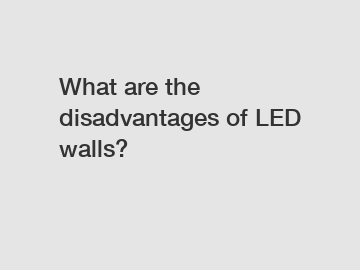Mar. 10, 2024
Consumer Electronics
Link to Sawink
LED walls have become increasingly popular in recent years for their vibrant displays and versatility. These large displays are used in a variety of settings, from concert venues and sports stadiums to retail stores and corporate offices. While LED walls offer many advantages, such as high resolution and brightness, there are also some disadvantages to consider.
One of the main drawbacks of LED walls is cost. LED displays can be quite expensive to purchase and install, especially for larger sizes. The cost of the display itself, as well as installation and maintenance, can add up quickly. Additionally, LED walls require specialized equipment and expertise to set up and maintain, which can further increase the overall cost.

Another disadvantage of LED walls is their energy consumption. LED displays require a significant amount of power to operate, especially when displaying bright, colorful content. This can result in high electricity bills for businesses and organizations that use LED walls regularly. In addition, LED displays generate heat, which can further increase energy consumption and require additional cooling systems to prevent overheating.
One common issue with LED walls is pixelation. Because LED displays are made up of individual pixels, there can be a noticeable grid-like pattern when viewing content up close. This can be distracting for viewers, especially when displaying high-resolution images or videos. To combat pixelation, many LED displays use smaller pixels and higher resolutions, but this can also increase the overall cost of the display.
LED walls are also susceptible to damage from external factors. The delicate nature of LED panels can make them vulnerable to scratches, dents, and other physical damage. Additionally, LED displays can be affected by environmental factors such as moisture, dust, and extreme temperatures. This can result in reduced lifespan and performance of the display if not properly protected and maintained.
One of the biggest challenges with LED walls is content creation and management. Creating engaging content for LED displays can be a time-consuming and complex process. Content must be optimized for the specific resolution and aspect ratio of the display, which can require specialized software and expertise. Additionally, managing and updating content on LED walls can be a logistical challenge, especially for businesses with multiple displays in different locations.
Despite these disadvantages, LED walls remain a popular choice for businesses and organizations looking to make a statement with dynamic digital displays. By carefully weighing the pros and cons of LED walls and implementing best practices for installation and maintenance, businesses can maximize the benefits of these versatile displays while minimizing potential drawbacks.
In conclusion, LED walls offer many advantages, but they also come with some disadvantages that should be carefully considered. From cost and energy consumption to pixelation and content management, there are several factors to weigh when deciding whether LED walls are the right choice for your business. By understanding the potential drawbacks and taking steps to mitigate them, businesses can make informed decisions about incorporating LED walls into their digital signage strategy.
If you want to learn more, please visit our website.
If you want to learn more, please visit our website stage led video wall manufacturer.
If you are interested in sending in a Guest Blogger Submission,welcome to write for us!
All Comments ( 0 )